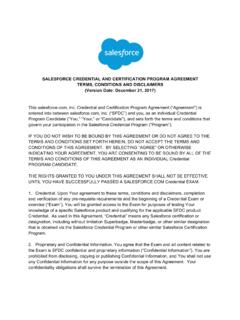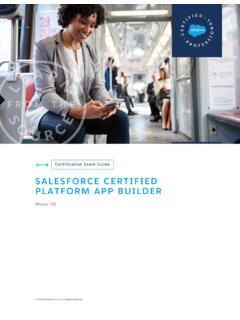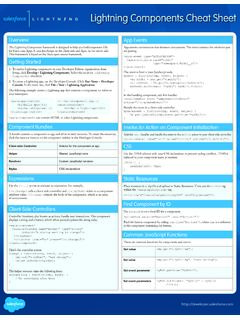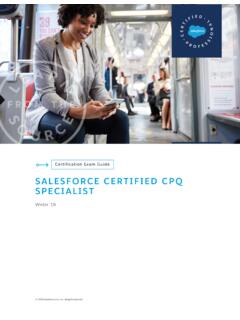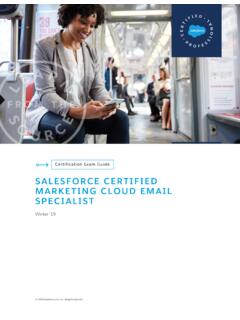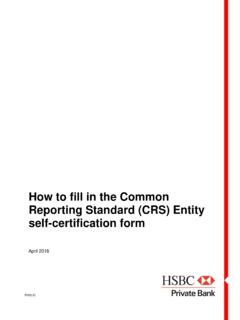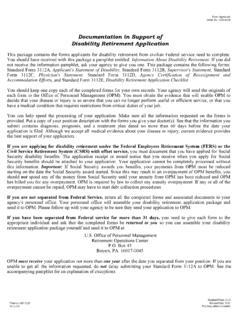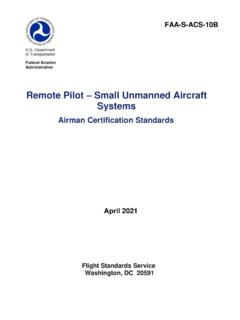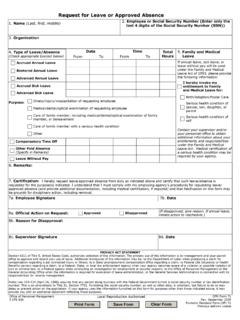Transcription of SALESFORCE CERTIFIED PLATFORM DEVELOPER I
1 2018 S , inc. All rights reserved. Certification Exam Guide SALESFORCE CERTIFIED PLATFORM DEVELOPER I Winter 19 SALESFORCE CERTIFIED PLATFORM DEVELOPER I Copyright 2018 , inc. All rights reserved. i CONTENTS About the SALESFORCE CERTIFIED PLATFORM DEVELOPER I Program .. 1 Section 1. Purpose of this exam Guide .. 2 section 2. Audience Description: SALESFORCE CERTIFIED PLATFORM DEVELOPER I .. 3 Section 3. About the Exam .. 4 Section 4. Recommended Training and References .. 5 Section 5. Exam Outline .. 6 Section 6. Sample Exam Questions .. 9 Section 7. Answers to Sample Exam Questions .. 11 Section 8. Maintaining a Certification .. 12 SALESFORCE CERTIFIED PLATFORM DEVELOPER I Copyright 2018 , inc. All rights reserved. 1 ABOUT THE SALESFORCE CERTIFIED PLATFORM DEVELOPER I PROGRAM The SALESFORCE CERTIFIED PLATFORM DEVELOPER I credential is intended for individuals who have knowledge, skills, and experience building custom applications on the Lightning Pl atform.
2 This credential encompasses the fundamental programmatic capabilities of the Lightning PLATFORM to develop custom business logic and interfaces to extend SALESFORCE using Apex and Visualforce. To achieve this credential, a candidate must successfully pass the SALESFORCE CERTIFIED PLATFORM DEVELOPER I exam. This exam is also a prerequisite to the SALESFORCE CERTIFIED PLATFORM DEVELOPER II Multiple Choice exam. This exam guide provides information about the SALESFORCE CERTIFIED PLATFORM DEVELOPER I exam. SALESFORCE CERTIFIED PLATFORM DEVELOPER I Copyright 2018 , inc. All rights reserved. 2 SECTION 1. PURPOSE OF THIS EXAM GUIDE This exam guide is designed to help you evaluate if you are ready to successfully complete the SALESFORCE CERTIFIED PLATFORM DEVELOPER I exam. This guide provides information about the target audience for the certification exam, recommended training and documentation, and a complete list of exam objectives all with the intent of helping you achieve a passing score.
3 SALESFORCE highly recommends a combination of on-the-job experience, course attendance, and self-study to maximize your chances of passing the exam. SALESFORCE CERTIFIED PLATFORM DEVELOPER I Copyright 2018 , inc. All rights reserved. 3 SECTION 2. AUDIENCE DESCRIPTION: SALESFORCE CERTIFIED PLATFORM DEVELOPER I The SALESFORCE CERTIFIED PLATFORM DEVELOPER I exam is intended for an individual who has experience developing and deploying basic business logic and user interfaces using the programmatic capabilities of the Lightning PLATFORM , including practical application of the skills and concepts noted in the exam objectives below. The SALESFORCE CERTIFIED PLATFORM DEVELOPER I generally has one to two years of experience as a DEVELOPER and at least six months of experience on the Lightning PLATFORM . The SALESFORCE CERTIFIED PLATFORM DEVELOPER I candidate has the experience, skills, and knowledge outlined below: Can use the fundamental programmatic capabilities of the Lightning PLATFORM to develop custom interfaces to extend SALESFORCE capabilities and develop custom business logic.
4 Can extend the Lightning PLATFORM using Apex and Visualforce, and understands Lightning Components. Is familiar with, and able to leverage relevant declarative capabilities of the PLATFORM , where appropriate. Knows when to use declarative vs. programmatic methods. Is familiar with the development lifecycle from development to testing, and has knowledge of the available environments. Is familiar with the SALESFORCE Mobile app capabilities and the basics of the Lightning framework. Knows when to use the Lightning Process Builder vs. an Apex trigger. Has experience with object-oriented languages such as Java, JavaScript, C#, Ruby, and .NET. Has experience with data-driven applications and relational databases. Has experience with Model View Controller (MVC) architecture and component-based architecture. Has invested time in studying the resources listed in this exam guide and the additional required study materials provided by SALESFORCE .
5 A candidate for this exam is not expected to administer any standard SALESFORCE applications, develop mobile apps, develop and publish managed products on the App Exchange, perform tuning or design integrations such as callouts, APIs, and email services. SALESFORCE CERTIFIED PLATFORM DEVELOPER I Copyright 2018 , inc. All rights reserved. 4 SECTION 3. ABOUT THE EXAM The SALESFORCE CERTIFIED PLATFORM DEVELOPER I exam has the following characteristics: Content: 60 multiple-choice/multiple-select questions Time allotted to complete the exam: 110 minutes Passing Score: 65% Registration fee: USD 200, plus applicable taxes as required per local law Retake fee: USD 100, plus applicable taxes as required per local law Delivery options: Proctored exam delivered onsite at a testing center or in an online proctored environment. Click here for information on scheduling an exam. References: No hard-copy or online materials may be referenced during the exam.
6 Prerequisite: None required; course attendance highly recommended. SALESFORCE CERTIFIED PLATFORM DEVELOPER I Copyright 2018 , inc. All rights reserved. 5 SECTION 4. RECOMMENDED TRAINING AND REFERENCES As preparation for this exam, SALESFORCE recommends a combination of: hands-on experience, training course completion, Trailhead trails, and self-study in the areas listed in the Exam Outline section of this exam guide. To enroll in instructor-led courses and launch online training from your SALESFORCE application, click the Help & Training link in the upper right corner of the screen (requires login) and search for the desired courses. Non- SALESFORCE customers can register for instructor-led courses here. Instructor-Led Training recommended for this exam: Programmatic Development Using Apex and Visualforce (DEV 450) Certification Preparation for PLATFORM DEVELOPER I (CRT 450) To review online Documentation, Tip Sheets, and User Guides search for the topics listed in the Exam Outline section of the exam guide and study the information related to those topics.
7 Documentation, Tip Sheets, and User Guides can also be accessed through Help & Training. Trailhead trails can be accessed here. Check out the official Certification Trailmix for this credential. We have included essential Trailhead learning specifically with you in mind. SALESFORCE CERTIFIED PLATFORM DEVELOPER I Copyright 2018 , inc. All rights reserved. 6 SECTION 5. EXAM OUTLINE The SALESFORCE CERTIFIED PLATFORM DEVELOPER I exam measures a candidate s knowledge and skills related to the following objectives. A candidate should have hands-on experience developing custom applications on the Lightning PLATFORM and have demonstrated the application of each of the features/functions below. SALESFORCE FUNDAMENTALS Describe the considerations when developing in a multi-tenant environment. Describe how the SALESFORCE PLATFORM features map to the MVC pattern. Describe the capabilities of the core CRM objects in the SALESFORCE schema. Identify the common scenarios for extending an application's capabilities using the AppExchange.
8 Identify common use cases for declarative customization of the Lightning PLATFORM , and customization and features of the Heroku PLATFORM . DATA MODELING AND MANAGEMENT Given a set of requirements, determine the appropriate data model. Describe the capabilities of the various relationship types and the implications of each on record access, user interface (UI), and object-oriented programming. Describe the impact of schema design and modifications on Apex Development. Describe how to visualize and create entity relationships. Describe the options for and considerations when importing and exporting data into development environments. LOGIC AND PROCESS AUTOMATION Describe how to programmatically access and utilize the object schema. Describe the capabilities and use cases for formula fields. Describe the capabilities and use cases for roll-up summary fields. Describe the capabilities of the declarative process automation features.
9 Describe when to use declarative automation features vs. Apex classes and triggers. Describe how to declare variables and constants in Apex and how to assign values using expressions. Describe the primitive and complex Apex data types and when to use them. Describe how to use and apply Apex control flow statements. Weighting 46% Weighting 10% Weighting 12% SALESFORCE CERTIFIED PLATFORM DEVELOPER I Copyright 2018 , inc. All rights reserved. 7 Describe how to write and when to use Apex classes and interfaces. Describe how to use basic SOSL, SOQL, and DML statements when working with objects in Apex. Describe the basic patterns used in triggers and classes to process data efficiently. Describe when to use and how to write triggers. Describe the implications of governor limits on Apex transactions. Describe the relationship between Apex transactions, the save order of execution, and the potential for recursion and/or cascading.
10 Describe how to implement exception handling in Apex. Describe how to write Visualforce controllers. Describe when and how to use standard Visualforce controllers vs. Apex custom controllers and controller extensions. Describe the programmatic techniques to prevent security vulnerabilities in Apex and Visualforce. Describe how Apex impacts the ability to make declarative changes. USER INTERFACE Describe how to display SALESFORCE data using a Visualforce page. Describe the types of web content that can be incorporated into Visualforce pages. Describe how to incorporate Visualforce pages into Lightning PLATFORM applications. Describe the benefits of the Lightning Component framework. Describe the resources that can be contained in a Lightning Component. TESTING Describe the testing framework and requirements for deployment. Describe how to write unit tests for triggers, controllers, and classes. Describe when and how to use various sources of test data.
